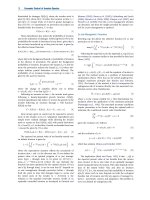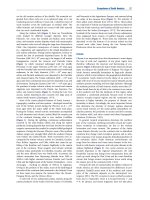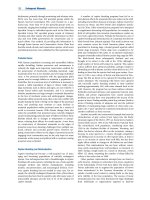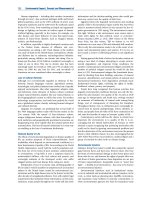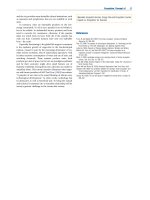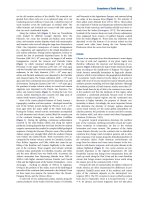Encyclopedia of biodiversity encyclopedia of biodiversity, (7 volume set) ( PDFDrive ) 1690
Bạn đang xem bản rút gọn của tài liệu. Xem và tải ngay bản đầy đủ của tài liệu tại đây (63 KB, 1 trang )
Ecosystems of South America
on the old erosion surfaces of the shields. The materials originated from these rocks are at an advanced stage of in situ
weathering and are millions of years old. A shallower layer of
waste material covers the landscapes of residual relief. The
valley bottoms and lowlands are covered with drift material
that can reach considerable depths.
Along the Andean belt (Figure 1) there are Precambrian
rocks masked by different younger deposits. Since the
Paleozoic, the ocean has invaded pre-Andean areas several
times, and extensive marine deposits mixed with metamorphic
and intrusive rocks occur all along the range from Venezuela to
Chile. One important consequence of marine transgressions
(i.e., ingressions and regressions) is the inland deposition of
rich marine sediments. During marine regressions, erosion increased the loss of previously deposited layers. In the Early
Devonian (408–362 Â106 years ago), the largest of all marine
transgressions covered the Amazon and Parnaiba basins
(Figure 1), which remained submerged until the middle
Devonian. In the upper Paleozoic (290–245 Â106 years ago)
only the Parnaiba basin received mixed marine and continental
sediments. In the Early Mesozoic (245B Â106 years ago),
eolian and fluviatile sediments were deposited in the Parnaiba
and Amazon basins. The Triassic sediments (208B Â106 years
ago) came from continental areas and were deposited in an arid
environment. During the Jurassic (208–145 Â B106 years ago),
the products of major volcanic activity in central and western
Argentina were deposited in the Parana´, Sao Francisco, Parnaiba, and Amazon basins (Figure 1). During the Late Cretaceous, marine depositions also occurred over large areas of
eastern South America (Harrington, 1973).
Most of the current physical features of South America –
topography, coastline, and river systems – developed toward the
end of the Tertiary period during the Pliocene (2–8 Â B106
years ago) when the major uplift of the Andes took place.
During the Tertiary, several tectonic movements accompanied
by acid intrusions and volcanic activity lifted the western part
of the continent forming what is now Andean Cordillera
(Figure 1). During the uplifting, continuous sedimentation
occurred in the inter-Andean valleys and along the eastern
piedmont, forming deposits that were later involved in Andean
orogenic movements that resulted in complex folded geological
sequences. During the Miocene–Pliocene, most of the northern
Andean ranges were strongly lifted while the southern Pampas
were broken into faulted blocks. These movements were accompanied by intense volcanic activity in Colombia, Ecuador,
Peru, Bolivia, Argentina, and Chile, which also cause the uplifting of the Brazilian and Guianan highlands in the eastern
part of the continent. These orogenic and volcanic activities
continue today, particularly in Colombia, Ecuador, and Chile,
and the areas affected have very fertile soils. At present, the
Andean mountains have fluctuating altitudes from 3000 to
5000 m with higher summits between Ecuador and Central
Chile and the highest peak of the Western Hemisphere – Cerro
Aconcagua – reaching an altitude of 7005 m in Argentina.
Owing to the position of the Andes, most of the hydrological
networks of the continent drain westward to the Atlantic Ocean
via three main river systems: the Amazon River, the Parana´–
Paraguay Rivers, and the Orinoco River.
A wide belt of low sedimentary plains extends along the
eastern piedmont of the Andes, from the Llanos of Colombia
107
and Venezuela to the Argentinean Pampas, and eastward along
the valley of the Amazon River (Figure 1). The majority of
these plains reach altitudes from 200 to 500 m. These plains
are composed of Tertiary and Quaternary sediments deposited
from the South American and Brazilian shields and more recently from the Andes (Harrington, 1973). The intercratonic
lowlands of the Amazon basin are made of heavy sedimentary
clays originated from erosion of uplifted deposits washed
from the Andes (Figure 1). Those deep clay sediments were
deposited on the flat bottom of an ancient inland sea that
covered most ofthe basin during the Late Tertiary–Early
Pleistocene when the ocean level was higher.
Climate
Climate is an important factor that determines to some degree
the type of soils and vegetation of any given region and,
therefore, influences the structure and functioning of ecosystems. Figure 2 illustrates the major South American climate
types according to the classification of Koăppen. The shape of
South America essentially determines its large-scale climatic
patterns, which in turn influence the geographical distribution
of ecosystems. South America has the shape of an acute triangle with most of its area situated in tropical latitudes and its
southern portion extending well into high latitudes. Although
the southern portion of South America reaches more than 201
farther South than the tip of Africa, the continent is so narrow
at the southern end that the landmass of this region rather
constitutes a continental peninsula. Because most of South
America occupies tropical regions and the continental area
decreases at higher latitudes, the property of climatic continentality is absent. Accordingly, the more important factors
that determine the diversity of climatic regimes observed
across South America are the major global atmospheric circulation patterns, the proximity to oceans and their currents,
the Andean relief, and other coastal and inland topographic
variations (Colinvaux, 1989).
In general, tropical temperatures dominate the northern
part of the continent, declining smoothly toward the south.
Major variations in temperature are due to the Andean
Mountains and ocean currents. The presence of the Andes
causes climatic diversity over the continent due to altitudinal
variations that change wind circulation patterns and to adiabatic responses of air masses along the altitudinal gradients of
the mountain chains. South American environments can
range from hot deserts and warm rainy climates in the lowlands to cold deserts, temperate, and iced polar climates in the
Andean highlands (Figure 2). Two ocean currents are particularly important to the regional temperatures: the cold
Humboldt Current that brings lower temperatures from the
south up north along the West Coast and the warm Brazilian
current that brings warmer temperatures down south along
the eastern part of the continent (Edit, 1968).
Owing to the lack of continentality, the distinct climates of
South America are often characterized by differences in precipitation. Rainfall across most of the northern and central
parts of the continent depends on the intertropical convergence (ITC). The ITC occupies its most northerly position
from June to September, when it is located between 71 and
91 N. Its advance and retreat migration does not take place
